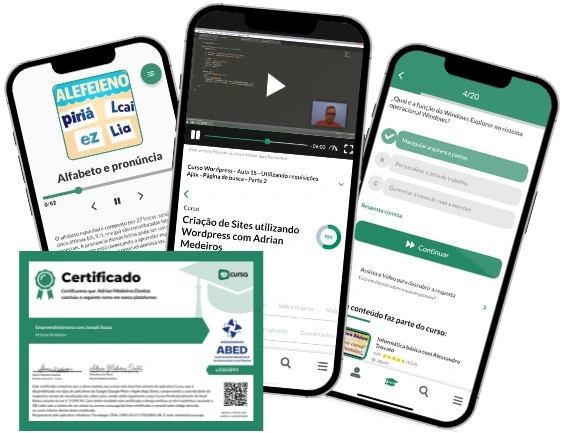
Free online courseElectronics - Nanoelectronics: Devices and Materials
Duration of the online course: 40 hours and 15 minutes
Explore the free "Electronics - Nanoelectronics: Devices and Materials" course by nptelhrd covering electronics fundamentals, nanoelectronics devices, and materials. Perfect for electricians!
In this free course, learn about
- Introduction to Nanoelectronics Devices and Materials
- MOSFET Scaling and Short Channel Effects
- Advanced Short Channel Effects and Gate Stack Materials
- MOS Capacitors and Capacitance Behavior
- Classical Nano MOSFETs and Carrier Transport
- SOI MOSFET Structures and Operation
- Source/Drain Engineering and Metal Contacts
- Alternative Semiconductor Materials for Nanoelectronics
- Introduction to Nanostructures and Nanosystems
- Quantum Mechanics Foundations for Nanoelectronics
- Nanocrystal Growth and Polymer Stabilization
- Nanoparticle and Nanostructure Fabrication Methods
- Structural Characterization of Nanomaterials
Course Description
The "Electronics - Nanoelectronics: Devices and Materials" course offered is a 40 hour and 15 minute intensive study program meticulously designed for aspiring professionals aiming to delve into the intricate world of nanoelectronics. This course boasts a stellar rating of 4.9 out of 5, a testament to its comprehensiveness and impact in the field of professional electrician courses.
With the ever-evolving landscape of electronics, this course provides an in-depth journey through the fundamentals and advanced concepts of nanoelectronics, emphasizing both devices and materials. Participants will embark on a structured learning path, starting with the basics of electronics and advancing towards the complexities of nano-scale devices.
The course is segmented into multiple modules, each comprising a series of lectures that collectively build a robust understanding of the subject. Whether you are just stepping into the field or looking to enhance your expertise, this course is designed to cater to a wide range of proficiency levels. Key topics include the foundational principles of nanoelectronics, various contemporary devices, and the materials that underpin their operation.
As learners progress through the modules, each lecture delves into critical aspects of nanoelectronics. From the theoretical underpinnings to practical applications, the course content is rich, engaging, and meticulously curated. The curriculum covers a broad spectrum of subjects, including the latest advancements and innovations in nanoelectronic devices, their material compositions, and how these breakthrough technologies are reshaping the future of electronics.
Participants will have the opportunity to engage with a variety of instructional mediums, including video lectures, practical demonstrations, and interactive discussions. The thoroughly planned course material ensures that key concepts are reinforced, and learners are well-prepared to tackle real-world challenges in the field of nanoelectronics.
The course not only focuses on imparting knowledge but also on evaluating learners' understanding through strategically placed assessments. These evaluations are designed to ensure that participants can effectively apply the concepts learned, demonstrating a solid grasp of both theoretical and practical aspects of nanoelectronics.
By the conclusion of this comprehensive course, participants will have gained a profound understanding of the devices and materials that are central to nanoelectronics. This knowledge will empower them to contribute meaningfully to this rapidly progressing sector, enhancing their professional capabilities and opening new avenues for innovation and career advancement.
Whether you're an electrician looking to specialize in nanoelectronics or a professional aiming to stay abreast of cutting-edge technological advancements, the "Electronics - Nanoelectronics: Devices and Materials" course offers an invaluable learning experience. Enroll now to start your journey in mastering the fascinating world of nanoelectronics.
Course content
- Video class: Electronics Nanoelectronics Devices and Materials mod01lec01 59m
- Exercise: What is the primary focus of the nanoelectronics course?
- Video class: Electronics Nanoelectronics Devices and Materials mod02lec02 1h00m
- Exercise: What was one of the reasons for introducing new materials in silicon chips?
- Video class: Electronics Nanoelectronics Devices and Materials mod02lec03 59m
- Exercise: _What is the short channel effect in a MOS transistor?
- Video class: Electronics Nanoelectronics Devices and Materials mod02lec04 59m
- Exercise: What are the two main isolation techniques in CMOS technology discussed, and how do they impact the narrow width effect?
- Video class: Electronics Nanoelectronics Devices and Materials mod02lec05 57m
- Exercise: _What is the effect of increasing substrate doping on sub threshold slope?
- Video class: Electronics Nanoelectronics Devices and Materials mod03lec06 58m
- Exercise: What is a potential downside of increased doping concentration in nanometer regime transistors?
- Video class: Electronics Nanoelectronics Devices and Materials mod03lec07 58m
- Exercise: _What is the reverse short channel effect in a transistor?
- Video class: Electronics Nanoelectronics Devices and Materials mod03lec08 59m
- Exercise: What is the primary advantage of silicon oxide as an insulator in transistors?
- Video class: Electronics Nanoelectronics Devices and Materials mod03lec09 59m
- Exercise: _What is the solution to overcome the problem of direct tunneling current in MOS transistors?
- Video class: Electronics Nanoelectronics Devices and Materials mod03lec10 54m
- Exercise: What is a primary reason for transitioning from metal gate to polysilicon gate in transistors?
- Video class: Electronics Nanoelectronics Devices and Materials mod03lec11 59m
- Exercise: What is the significance of using fluorine-doped silicon oxide in CMOS technology?
- Video class: Electronics Nanoelectronics Devices and Materials mod04lec12 58m
- Exercise: What is the effect of high frequency on the MOS capacitor's inversion capacitance?
- Video class: Electronics Nanoelectronics Devices and Materials mod04lec13 59m
- Exercise: _What happens to the threshold voltage and inversion capacitance when substrate doping concentration is increased while keeping the oxide thickness constant in an ideal capacitor?
- Video class: Electronics Nanoelectronics Devices and Materials mod04lec14 1h09m
- Exercise: What type of hysteresis occurs with slow interface traps in MOS capacitors?
- Video class: Electronics Nanoelectronics Devices and Materials mod04lec15 53m
- Exercise: _What is the saturation current value (Idsat) of a field effect transistor?
- Video class: Electronics Nanoelectronics Devices and Materials mod05lec16 53m
- Exercise: What is the primary factor determining the performance of classical MOSFETs?
- Video class: Electronics Nanoelectronics Devices and Materials mod05lec17 57m
- Exercise: _What is the sub threshold slope or sub threshold swing in a nano MOSFET?
- Video class: Electronics Nanoelectronics Devices and Materials mod05lec18 59m
- Exercise: What principle explains unmet velocity expectations in high electric fields?
- Video class: Electronics Nanoelectronics Devices and Materials mod06lec19 59m
- Exercise: _What is the factor that controls the injection velocity in SOI MOSFETs?
- Video class: Electronics Nanoelectronics Devices and Materials mod06lec20 59m
- Exercise: What is a key characteristic of a fully depleted SOI MOSFET?
- Video class: Electronics Nanoelectronics Devices and Materials mod06lec21 1h00m
- Exercise: _What are the different modes of operation in the case of SOI compared to bulk MOSFET?
- Video class: Electronics Nanoelectronics Devices and Materials mod06lec22 59m
- Video class: Electronics Nanoelectronics Devices and Materials mod07lec23 59m
- Exercise: _What is the reason for the change from conventional p-n junction to metal source drain junctions in small scale or nano scale MOSFETs?
- Video class: Electronics Nanoelectronics Devices and Materials mod07lec24 59m
- Video class: Electronics Nanoelectronics Devices and Materials mod07lec25 59m
- Exercise: _What is the ideal barrier height for an ohmic contact on an n-type material in metal-semiconductor contacts?
- Video class: Electronics Nanoelectronics Devices and Materials mod08lec26 58m
- Video class: Electronics Nanoelectronics Devices and Materials mod08lec27 59m
- Exercise: _What is the most important thing required for using Germanium for MOS devices?
- Video class: Electronics Nanoelectronics Devices and Materials mod08lec28 59m
- Video class: Electronics Nanoelectronics Devices and Materials mod08lec29 59m
- Exercise: _What is the benefit of using gallium arsenide and indium phosphide devices over silicon devices?
- Video class: Electronics Nanoelectronics Devices and Materials mod08lec30 1h03m
- Video class: Electronics Nanoelectronics Devices and Materials mod09lec31 1h00m
- Exercise: _What is the definition of nanostructures or nanosystems?
- Video class: Electronics Nanoelectronics Devices and Materials mod10lec32 52m
- Video class: Electronics Nanoelectronics Devices and Materials mod10lec33 55m
- Exercise: _What is the Schrodinger equation?
- Video class: Electronics Nanoelectronics Devices and Materials mod10lec34 55m
- Video class: Electronics Nanoelectronics Devices and Materials mod10lec35 57m
- Exercise: _What is the energy width of the bands representing the outer core or valence electrons in a crystal?
- Video class: Electronics Nanoelectronics Devices and Materials mod11lec36 56m
- Video class: Electronics Nanoelectronics Devices and Materials mod11lec37 57m
- Exercise: _What is the purpose of polymer stabilizers in the growth of nanocrystals of metals and semiconductors?
- Video class: Electronics Nanoelectronics Devices and Materials mod11lec38 55m
- Video class: Electronics Nanoelectronics Devices and Materials mod12lec39 57m
- Exercise: _What are some physical methods that can be used for producing nanoparticles and nanostructures?
- Video class: Electronics Nanoelectronics Devices and Materials mod12lec40 53m
- Video class: Electronics Nanoelectronics Devices and Materials mod13lec41 1h16m
- Exercise: _What is the Bragg equation used for in external diffraction?
This free course includes:
40 hours and 15 minutes of online video course
Digital certificate of course completion (Free)
Exercises to train your knowledge
100% free, from content to certificate
Ready to get started?Download the app and get started today.
Install the app now
to access the courseOver 5,000 free courses
Programming, English, Digital Marketing and much more! Learn whatever you want, for free.
Study plan with AI
Our app's Artificial Intelligence can create a study schedule for the course you choose.
From zero to professional success
Improve your resume with our free Certificate and then use our Artificial Intelligence to find your dream job.
You can also use the QR Code or the links below.

More free courses at Electrician

Free CourseEngineering Circuits Analysis

3h11m

20 exercises

Free CourseSiemens PLC Training

9h42m

32 exercises

Free CourseElectronic Circuits Course

43h25m

49 exercises

Free CourseElectronic Circuit Design Course

9h31m

51 exercises

Free CourseBeginner Electronics

5h27m

24 exercises

Free CourseElectricity course

31h41m

6 exercises

Free CourseElectrical - Fabrication of Silicon

35h10m

28 exercises

Free CourseBasic electronics

6h04m

30 exercises

Free CourseElectrical Engineering Basics

7h21m

27 exercises

Free CourseElectrical engineering

11h53m

20 exercises

Free CourseEngineering Circuits Analysis
3h11m
20 exercises

Free CourseSiemens PLC Training
9h42m
32 exercises

Free CourseElectronic Circuits Course
43h25m
49 exercises

Free CourseElectronic Circuit Design Course
9h31m
51 exercises

Free CourseBeginner Electronics
5h27m
24 exercises

Free CourseElectricity course
31h41m
6 exercises
Free CourseElectrical - Fabrication of Silicon
35h10m
28 exercises

Free CourseBasic electronics
6h04m
30 exercises

Free CourseElectrical Engineering Basics
7h21m
27 exercises

Free CourseElectrical engineering
11h53m
20 exercises
Free Ebook + Audiobooks! Learn by listening or reading!
Download the App now to have access to + 3300 free courses, exercises, certificates and lots of content without paying anything!
-
100% free online courses from start to finish
Thousands of online courses in video, ebooks and audiobooks.
-
More than 48 thousand free exercises
To test your knowledge during online courses
-
Valid free Digital Certificate with QR Code
Generated directly from your cell phone's photo gallery and sent to your email

Download our app via QR Code or the links below::.







Course comments: Electronics - Nanoelectronics: Devices and Materials
kavinesan .P
ok,good